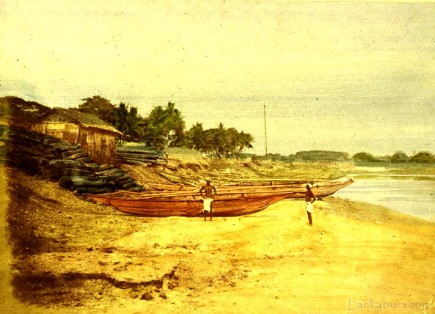
Photographer: Fiebig, Frederick (Francis Fiebig)
Medium: Hand-colored salt prints
Date: 1852
Sinhalese boats in Sri Lanka (Ceylon).
Photographer Frederick Fiebig was originally an artist and lithographer in Calcutta in the 1840s. He took up photography in ca. 1849 and in the early 1850s produced nearly 500 calotypes of the architecture and scenery of Calcutta, Madras, Sri Lanka, Mauritius and Cape Town. ‘Views in Sri Lanka’ comprised 70 prints which were purchased by the East India Company in 1856.
John Deschamp described Sinhalese native canoes in ‘Scenery and Reminiscences of Ceylon’, London, 1845: ‘Their construction is very simple, but has been allowed by scientific nautical men to be that best adapted to give the greatest swiftness to a sailing machine. The lower or main part is formed of the trunk of a cocoa-nut tree hollowed out, being about fifteen feet in length. Along the upper edges a row of planks is sewed on (no nails being used by the natives in the construction of their canoes, or dhoneys) to raise them above the surface of the water; and to prevent the canoe from capsizing, a log of very light wood is secured to it, in a parallel direction, at the distance of about six feet. It has one very large square sail, supported by two slender masts or poles. From the tops of these poles, ropes extend to the outrigger, steadying them’. The canoes had paddles which the fishermen occasionally managed with their feet, keeping their hands free for fishing. Deschamps wrote, ‘The fishermen daily venture out to sea ten or fifteen miles, and an accident rarely occurs, as the canoe cannot sink, even if filled with water, and as long as the outrigger remains firm they are safe’.